For the sake of jumpstarting your higher-level judgment processes, let’s assume that I am a stockbroker and that you are in my office seeking investment counsel. Next, let’s assume that I am telling you the story of a top notch, high-powered U.S. company whose management leaders are internationally recognized as not only “experienced”, but as virtual experts in the industry! In addition, the company’s financials report a higher “Return on Equity” than five of its rivals. This company’s stock currently sells for less than its “Book Value” and it is very liquid — with the thinnest of bid/ask spreads. Looking forward, as the U.S. and world economies recover further and begin to demonstrate sustainable growth, this company’s sales and revenue will reap considerable tailwinds! Then I show you the chart of price action over the course of the past ten months:
By that point, you might have become interested in considering purchase of the security. However, one thing is nagging at you[1]: you have noticed that I have not offered any “bullet points” regarding the challenges this company faces looking ahead! So you request that I fill you in on why you might not want to be a buyer of the stock.
Being (if nothing else) a customer-oriented person, I pause to reflect for a moment. Then I tell you: “Thanks for asking about that. There is one challenge the company is currently working through. They have been wrestling with a few significant legal issues. But the great news is that company management is currently negotiating a comprehensive settlement of those issues. In fact, the negotiations are proceeding as we speak, and importantly, key U.S. Justice Department leaders and this company’s CEO are each committed to getting a settlement arranged before year-end! If that process moves to completion, the market is sure to respond very positively!”
Ah, I can tell that I have captured your imagination and your interest! In fact, what is that speck at the left side of your mouth? Are you actually salivating at the prospect of the capital gains you can imagine reaping after you purchase this stock?
Perhaps you had better take a deep breath and perform a bit more due diligence, my friend! The company that I have just described is JP Morgan Chase and Company (JPM). You may have noticed that, in addition to the standard news coverage focused upon a $200 billion international bank (and member of both the Dow Jones Industrial Index and the S&P 500 Index), JPM has (during the past two-three years) made frequent appearances in the “legal notices” section of the financial news!
However, there has lately emerged a fascinating and telling trend within those “legal” stories regarding JPM. In former years, the “standard issue settlement” between a U.S. corporation and a U.S. regulatory agency or court would include language such as “the company has agreed to pay a fine of $XXX,000 dollars, but neither admits nor denies any wrongdoing.” However, at least regarding certain actions taken by the U.S. Securities and Exchange Commission (SEC), those days are now past, and JPM has evidently “seen the light”.[2]
In fact, just this past week, the head of the JPM Board Audit Committee (Laban Jackson) is quoted as having said: “We've got these things that we actually are guilty of and we've got to fix them. It's embarrassing for the board.”[3] If the deceased author of any corporate law textbook was to suddenly reappear (ala Rip Van Winkle) and read that, he/she would certainly suffer immediate shock, if not full bore cardiac arrest, since “denial of wrongdoing” has been the essential standard ‘legal stance” for centuries. In fact, if I had just $1 for all the times I have had to read “this suit is without merit, and we will defend ourselves vigorously” in corporate reports/disclosures, I would be rich.
Therefore, the fact that the JPM Board of Directors (who bear a fiduciary duty for the oversight of the company) have voluntarily arrived at the point of public “confession”[4] is a telling barometer of how far the directors have been pushed beyond “business as usual” within the United States’ biggest bank. In fact, in my opinion it is the fact that those directors have been pushed to that “breaking point” that serves as the motivating force behind CEO Jamie Dimon’s current “full court press”[5] to resolve the bank’s legal issues (in that comprehensive settlement through the U.S. Justice Department I referred to earlier). That was the purpose of the extremely rare “face to face” legal negotiations this past week in Washington D.C. between Dimon and the U.S. Attorney General, Eric Holder.
 IMAGE TO LEFT: This is not a life like depiction of either Mr. Dimon or board members! But the negative public attention that JPM has been receiving must feel to them as though they are (in a virtual sense) suffering the same fate as this gentleman.
IMAGE TO LEFT: This is not a life like depiction of either Mr. Dimon or board members! But the negative public attention that JPM has been receiving must feel to them as though they are (in a virtual sense) suffering the same fate as this gentleman.
The current legal actions still facing JPM are so numerous that it consumes ten pages of fine print in the company’s 10-K Filing for the year ended 12/31/12 (filed 2-28-13). Dimon is endeavoring to wrap all of those matters (and I am sure some others, as well) into one big package so he can free the Board (and himself) from the continual distraction and embarrassment that inevitably follows the public reporting of each separate legal action, one-by-one.
Reports are that “negotiations” began from JPM’s side with an initial offer of $3 billion to “settle all”. I am actually surprised that Justice Department leaders didn’t immediately laugh Dimon and his team right out of the Justice Department’s building and order them to return to New York City immediately[6]. After all, right there on page 325 of the JPM 10K, is the company’s own assessment that the 2013 legal bill would likely total $6.1 billion![7]
As negotiations continued, they seem to have migrated toward a total of $11 billion (encompassing a combination of “regulatory fine” and “consumer relief/restitution”). It appears that remaining issues (huge ones, to be sure) include at least: 1) how to wrap up all actions into one, including individual state suits; 2) to what extent (if any) JPM will admit wrongdoing.
One thing is reasonably certain: the “personal stakes” for each of the two primary negotiators (Dimon and Holder) are extraordinarily high. Incentives for Holder include an opportunity to ensure his own reputation as an “enforcer” of corporate regulation. Any settlement within the order of $11 billion is guaranteed to be a “record breaker” on multiple fronts; and if (as has been reported) he is contemplating leaving the Attorney General position after the end of the year, it could add a hard-to-miss “star” to the legacy he has woven at Justice. For Dimon, he is madly trying to recapture the “luster” that once was his, after he (seemingly) steered JPM through the treacherous shoals and storms of 2007-09 while evading shipwreck and/or flood![8] He is so intent on his personal quest to get these matters settled that he has decided to lead JPM’s side of the negotiations on his own rather than trusting them to (mere) attorneys!!
Since there is no way that I could possibly hope to find the time to write a comprehensive look at JPM under these current conditions (much less expect you to spend the time reading it), I have refined my focus to outlining what I think are the central issues regarding JPM, letting you judge how the market has responded to these issues, and suggesting some ways in which Chase’s most historic “icon” – John Pierpont Morgan – seems to have demonstrated the truth that “past is prologue”!
First of all, let’s take a “macro” look at the most visible “warts” on the face of JPM: the bank’s growing legal challenges! Consider for a moment what a transformation[9] has taken place between 2008 and today! In the darkest days of 2008, as financial liquidity dried up and the U.S. financial system was in danger of a “meltdown” – one Jamie Dimon “had a seat at the table of power”. Such notables as Federal Reserve Chair Ben Bernanke, New York Fed President Tim Geithner, and U.S. Secretary Henry Paulson turned to Dimon for counsel… and help! At that time, the balance sheet of JPM appeared strong enough to absorb two mounting “headaches” for the federal government – (first) Bear Stearns and (later) Washington Mutual. Dimon negotiated terms for JPM’s acquisition of each with the government. I remember those dark days, during which the financial press painted this story as though Dimon was a cross between Superman and the Good Samaritan – “stepping up” when his country needed him to make a sacrifice!
As it turns out, historic reality paints Dimon and JPM as something much less than “heroic”. For your edification, I provide you with a full paragraph “endnote” regarding the takeover of Bear Stearns (see end of article). Those details suggest the tenor of the expedited delivery of two major financial entities into the corporate circle of JPM — for which the government had to approve (as well) an almost “instant” transformation of JPM from investment bank into “bank holding company”. Many disparate elements are involved here, but just permit me to summarize that the “end result” was simple: JPM became an instant “behemoth”. And it became a behemoth by purchasing “assets” at a greatly discounted price, not to mention the massive government subsidies and significant assurances that were added by the U.S. government![10]
This particular development[11], combined with the financial bailout in general, is crucial to a theme that weaves its way through the JPM story from here on out. If there is such a thing as “too big to fail”[12] then JPM is “the biggest” and the market recognizes that fact by treating it as though it has an implicit “government guarantee”. This results in JPM enjoying lower rates, higher stock premium, more “leeway” with regulators, higher status in Washington D.C., and even 40 minute one-on-one legal negotiation sessions with the U.S. Attorney General!
 At this point, the recent history of JPM echoes that of its namesake, J.P. Morgan (see image to the right of Morgan in 1895)! There are several relevant examples of Morgan’s history, of which I will highlight just two:
At this point, the recent history of JPM echoes that of its namesake, J.P. Morgan (see image to the right of Morgan in 1895)! There are several relevant examples of Morgan’s history, of which I will highlight just two:
1) Did you know that the U.S. was in danger of default in February of 1895? The nation was still in the grip of a severe depression and the U.S. federal government’s gold reserves (upon which its “full faith and credit” was founded) were rapidly dwindling to nothing. President Grover Cleveland faced a hostile Congress (dead set against authorizing a new issuance of bonds that could be sold for gold), a Treasury Secretary who hated gold and wanted to move federal finance toward silver, and a public with whom he was falling out of favor.
a. To the rescue rode on J.P. Morgan – as ever well connected within U.S. and European banking circles.
b. Morgan engineered a banking coalition – banks within the U.S./Europe coalition were to receive the U.S. bonds in return for 3.5 million ounces of gold from their vaults. That transaction “saved” the U.S. from default.
c. You owe it to yourself to read a detailed narrative, including Morgan showing up in Washington unannounced, insisting to meet with Cleveland, and then sitting through a long, nail-biting, high stakes session of gamesmanship – during which Morgan held all the cards, including:
i. Knowledge that, at a particular time that day, the U.S. had already slipped into default;
ii. Knowledge of an obscure Civil Ware era statute that would empower Cleveland to declare an emergency and finalize the “bonds for gold” deal.
d. The U.S. was saved!
e. Morgan and his partners enjoyed a hefty profit from “marking up” the bonds as they sold them to levels that even today’s Goldman Sachs might find unconscionable!
2) In 1907, the U.S. faced the “Panic of 1907”, or as more colorfully named, the “Knickerbocker Crisis”.[13]
a. To make this story brief, its roots were in a national bank run, causing a liquidity crisis, which also threatened the functioning of the stock exchange. (Sound familiar?)
b. Morgan “stepped up” once again – throwing much of his personal fortune into the breech (like the Dutch boy’s finger in the dike) and arranging for a big meeting among bankers and industrialists to straighten things out.
c. The end result was:
i. The day was saved.
ii. Morgan profited significantly.
iii. Morgan’s power swelled even further.
iv. Morgan got a special exemption from anti-trust regulations directly from President Roosevelt, thereby enabling a buyout of one steel company by the very steel company controlled by Morgan.[14]
Let’s take a look at the laundry list of legal liabilities with which JPM has been hit during the past 2.5 to 3 years:
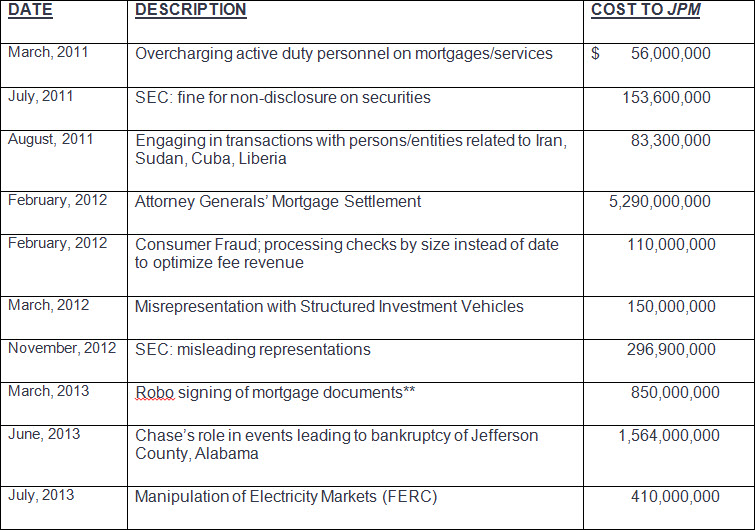
** NOTE: JP Morgan has refused to disclose its share of the $8.5 billion fine levied by the Office of the Comptroller of the Currency (OCC) and the Federal Reserve on ten U.S. banks. I conservatively estimated the JPM “share” of that fine by arbitrarily dividing the total fine by the number of banks involved!
Take a good, lingering look at the above table. Does anything stand out to you? First, of course, the amounts are staggering. In fact, since the usual shorthand method (eg. $3 million) disguises that magnitude, I decided to use all the necessary digits in reporting each fine!
When I looked at the descriptions of these violations, my eyes were caught by these particular “misdeeds”:
a) Overcharging active duty (military) customers… JPM “gouged” our nation’s defenders”??!!
b) Transactions within countries declared “off limits” by our own national leaders??!!
c) “Check processing fraud” – rigging the fee system in favor of the bank!!!
d) Manipulating the Electricity Market!!
e) Choosing to market overpriced property insurance to customers so the bank gets “kickbacks”!!
I personally have problems with a few of the others, as well… but when I read about the items above, I wanted to say: “Duh! Which JPM executive was sufficiently insane to approve that?” Those are not actions recommended by Dale Carnegie to endear ones self to current or potential customers!
Let’s put these fines in context. According to YahooFinance.com, the most recent financial figures for JPM included:
$95.140 billion in REVENUE
$93.650 billion in GROSS PROFIT
$22.900 billion in NET INCOME (Trailing Twelve Months)
Since the time period incorporated within our list of fines stretches from April of 2011 to September of 2013, we have about 2.5 years. Therefore, just 2.5 years of JPM fines/assessments/penalties equals almost 46% of the most recent Net Income… or 11.1% of this past year’s total Revenue!!
Here is another vantage point on these matters, using data straight from the 12/31/2012 10K Filing provided to the SEC as of 2/28/2013. On pages 316-325, all relevant litigation facing JPM was listed. Then on page 325, management represents litigation expenses for the years ended 12/31/10, 12/31/11, and 12/31/12 to have been (respectively) $7.4 billion; $4.9 billion; and $5.0 billion. That totals $17.3 billion over three years – over 75% of last year’s Net Income! Management ends this section by representing that their best estimate of 2013 expense would be $6.1 billion! (We’ve reached $4.4 billion already!).
Please note that, very importantly, those costs do not include the incremental costs to JPM (over and above the “usual and customary level” of legal staff hired as FT employees of a bank the size of JPM) to pay for adequate legal representation on all of the litigation matters involving JPM! I have spent hours pouring over the JPM financials and performing internet searches on “Total Litigation Expense for JP Morgan Chase” — all to no avail. Obviously, they do have extremely complex financial accounting. However, that figure should not be virtually impossible to locate – especially when legal expenses are currently an extremely “material” component of the company’s financial condition!
Why do I consider the above a serious matter of public policy and shareholder equity?[15] Who do you think (ultimately) pays for the legal failings of the JPM management and its Board? It is not Mr. Dimon. He is not personally charged for any fine or penalty. Nor is it his management team or Board of Directors. They don’t get charged either! It is the shareholders who pay – through reduced net income from the fines, as well as the much higher costs for legal staff and outside counsel!
However, we aren’t through yet! Who else pays the freight for each and every legal miscue of JPM? Here is a partial list:
1) The U.S. Taxpayer: JPM is (generally) permitted to deduct these costs from taxable income, thereby reducing what would otherwise become U.S. tax revenue. (Therefore, their fines indirectly add to federal budget deficits and/or detract from any (however rare) surplus);
2) More direly, if JPM were to come close to “blowing up” (ala AIG, Bear Stearns, GM, etc.) the taxpayers’ resources would surely be “brought in” to shore up JPM and/or the banking system (once again)!
3) JPM customers, business-to-business partners, counter-parties within securities transactions, etc.
a. In most instances, it took a good deal of time for the banks’ misdeeds to “come to light”.
b. In the meantime, the above folks have been (at best) disadvantaged and (at worst) cheated.
c. It is unknown how many instances of “misdeeds” there have been that will never be “uncovered”.
How do you feel about all that which you have learned (or reviewed) above? As I consider these matters, it astounds me that the market seems (largely) oblivious. Consider these price graphs:
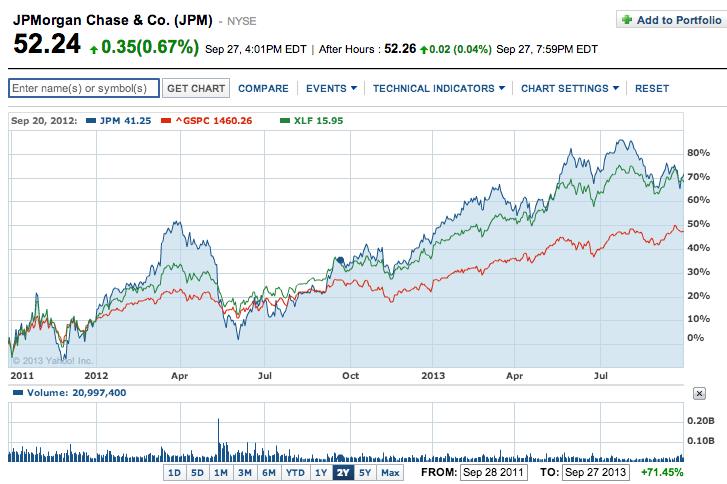
Over the prior two-year period, JPM (Blue) has outperformed the S&P 500 (Red) and the Financial Select Sector SPDR Fund (XLF)!
Meanwhile, on a YTD basis, JPM has performed at the pace of the S&P 500, but under-performed XLF by about 4%.
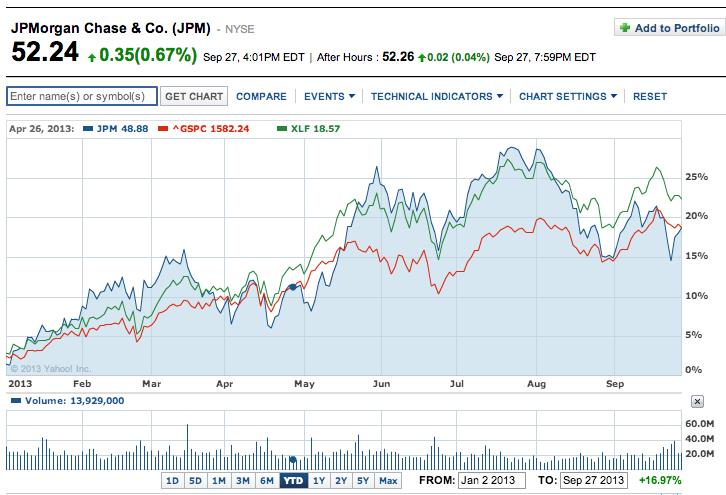
The only period of significant under-performance has been over the past 3-months, with JPM falling 4-6% behind.
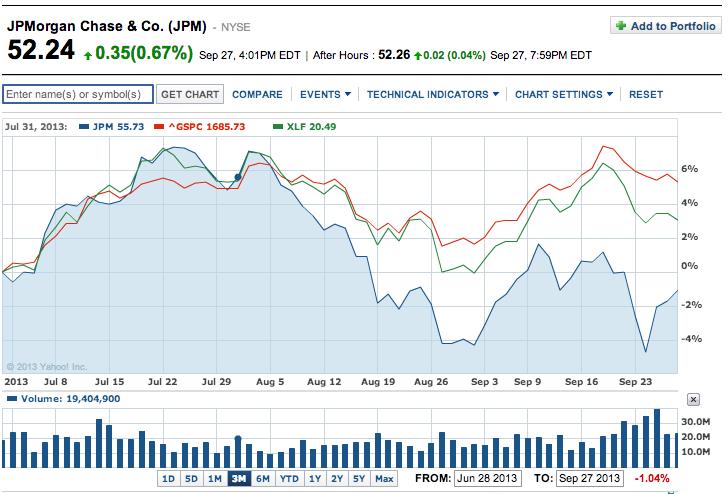
But (is anyone surprised?) as word got out regarding Dimon’s “face-to-face” with Holder, JPM far outperformed on a really bad day (the market tanked because of the specter of government “shutdown”).
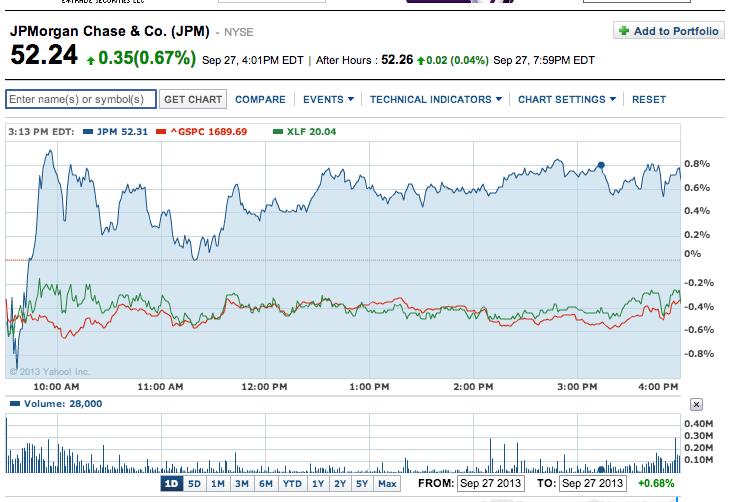
The confirmed cynic in me wonders if some Wall Street veterans were thinking: “Thank heavens Dimon is going to ‘get away with it!’” Along that line of thinking, some may decide – “We might shutdown the government, but they can never shut down JP Morgan Chase!
INVESTOR TAKEAWAYS: Today’s takeaways are in no way oriented toward trading tools or techniques or analytical charts/numbers. Instead, this article was intended to help you (hopefully) do the following:
1) Be aware of the need to be skeptical whenever a stock is “pitched” to you. Note that nothing the imaginary broker in my initial story said about JPM was untrue. However, what that broker told you about JPM did misrepresent the company. There is a distinct and crucial difference between lying and misrepresentation – and that is precisely the point!
a. The broker misrepresented the stock because he failed to disclose all the most material facts about JPM.
b. Ironically (as you noticed) many of JPM’s misdeeds stem from misrepresentation or failure to disclose!!
c. Whenever you watch interviews on CNBC or Bloomberg, keep in mind that none of those persons is legally liable to properly disclose all material facts to you; therefore, process everything you hear with a skeptic’s eye.[16]
d. Finally, never buy JPM stock from that broker!!
2) At the risk of sounding unpatriotic, the honest fact is that our constitutionally limited representative democratic republic has a history that is filled with noble sacrifices, brilliant decisions, and incredible creativity… but also rife with injustices, governmental favoritism, and treasonous behavior.
a. Keep that in mind as you read contemporary reports/interpretations of “history” as it occurs.
b. As Jamie Dimon has demonstrated, there can be a fine line (easily crossed) between the “best managed U.S. bank” and the “most heavily fined” U.S. bank, trying to overcome a long litany of expensive litigation (well over $17 billion in just three years!).
c. Always bear in mind that, not withstanding that George Washington and Abraham Lincoln might have been faultless men of virtue, the legion of political leaders who have followed since then all have, decidedly, “feet of clay”
i. One might posit that the current crop of leaders must share a common mission – to convince every last one of us, even the idealistic “holdouts”—that they are flawed!
3) Provide you with as comprehensive a picture as possible (in one spot) of the current “story” behind JPM.
a. If we rely strictly on daily or weekly reports, we will (almost invariably) miss the “big picture”.
b. Without the “big picture”, we become limited in our understanding, thereby exposing ourselves to decision-making that is not all it could be.
4) Convince you that there is virtue in understanding history – since we frequently find that the adage “Past is Prologue” is true enough to offer us insights that can prove themselves to be illuminating and productive.
a. I would in no way suggest that Jamie Dimon is capable of operating on a level comparable to that demonstrated by J.P. Morgan.
b. I would, however, suggest that, as an institution, JPM has been exhibiting many of the behavioral patterns that were evident within the professional history of its iconic namesake!
We’ll pick up the rest of the story in Part II.
ENDNOTE: On March 14, 2008, the Federal Reserve Bank of New York agreed to provide a $25 billion loan to Bear Stearns collateralized by free and clear assets from Bear Stearns in order to provide Bear Stearns the liquidity for up to 28 days that the market was refusing to provide. Apparently the Federal Reserve Bank of New York had a change of heart and told Bear Stearns that the 28 day loan was unavailable to them. The deal was then changed to where the NY FED would make a $30 billion loan to J.P. Morgan (collaterallised not by any J.P. Morgan assets but collaterallised by Bear Stearns Assets), who would buy Bear Stearns for 2 dollars per share.[19] Two days later, on March 16, 2008, Bear Stearns signed a merger agreement with JP Morgan Chase in a stock swap worth $2 a share or less than 7 percent of Bear Stearns' market value just two days before.[20] This sale price represented a staggering loss as its stock had traded at $172 a share as late as January 2007, and $93 a share as late as February 2008. In addition, the Federal Reserve agreed to issue a non-recourse loan of $29 billion to JP Morgan Chase,[21]thereby assuming the risk of Bear Stearns's less liquid assets. This non-recourse loan means that the loan is collateralized by mortgage debt[22] and that the government can not seize JP Morgan Chase’s assets if the mortgage debt collateral becomes insufficient to repay the loan.[22][23] Chairman of the Fed, Ben Bernanke, defended the bailout by stating that a Bear Stearns' bankruptcy would have affected the real economy and could have caused a “chaotic unwinding” of investments across the US markets.[20][17]
DISCLOSURE: The author does not currently own JPM or XLF. However, in an instance of extremely rare Buffett-like Brilliance, he did buy JPM in 2008 below $17/share. Nothing in this article is intended as a recommendation to buy or sell anything. Always consult with your financial advisor regarding changes in your portfolio – either subtractions or additions.
[1] No, silly, not your spouse!!
[2] For more insights on this topic, see: http://www.paulhastings.com/docs/default-source/the-way-we-work—publications/secs-guilt-admission-policy-may-bring-pricey-trials.pdf?sfvrsn=2
[3] Bold font was inserted by the author for emphasis.
[4] I’d liken this to the modern version of the old “stocks” punishment – a “guilty” party held on public display for the misdeed.
[5] Yes, the pun is entirely intentional.
[6] “Do not pass GO; do not collect $200!”
[7] And such an estimate would not even begin to contemplate all legal actions being resolved in 2013!
[8] It seems like it was eons ago that Dimon was regularly touted as the “best risk manager” in U.S. banking and was fawned over by press and politicians alike. There was even talk in mid to late 2012 that Dimon was being considered as a replacement for Tim Geithner as U.S. Treasury Secretary! Needless to say, those days have long since passed.
[9] A “transformation” so profound that it almost seems like a 180% turn.
[10] Note, for example, that Dimon already hungered and thirsted for Washington Mutual. In the spring of 2008, he offered them $4/share in a buyout and was rejected. He ended up getting it much more cheaply via the government.
[11] JP Morgan Chase becoming a financial behemoth…
[12] Ignore any politician or commentator who claims that 2008 will never happen again because we have “learned the dangers of too big to fail!”… That person is either lying, blind, or an imbecile. The U.S. cannot allow JPM to “fail”.
[13] Many experts attribute these crises to the creation (soon thereafter) of the Federal Reserve, as a financial backup and “final resort” (preparing for the day J.P. Morgan would no longer be alive and available during a crisis).
[14] One additional story is all too telling (and in a way is a parable of the recent mortgage crisis): Just after college and during the Civil War, J.P. Morgan bought five thousand rifles for $3.50 each from an army arsenal, and sold them to a general in the field for $22 each. The rifles were defective and would shoot off the thumbs of the soldiers using them. A congressional committee noted this in the small print of an obscure report, but a federal judge upheld the deal as the fulfillment of a valid legal contract.
[15] In my deep, abiding concern, by the way, I am in no way alone. Many experts and commentators are incensed.
[16] Think to yourself: “I’m from Missouri. You are going to have to show me!”
[17] From http://en.wikipedia.org/wiki/Bear_Stearns
Related Posts
Also on Market Tamer…
Follow Us on Facebook

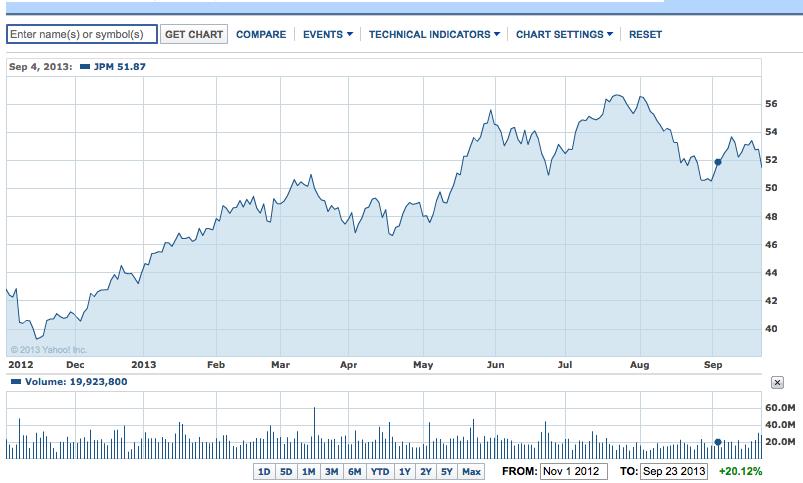
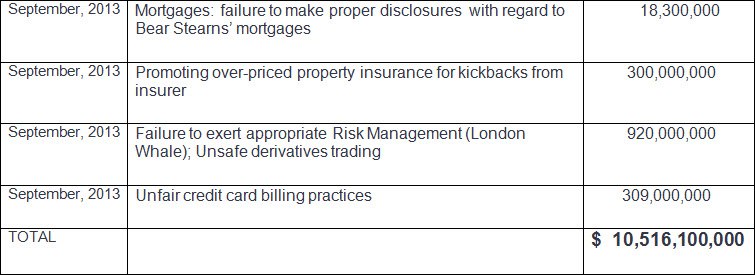
 We're About to Find Out the Answer to Warren Buffett's Pointed Question About Trump's Tariffs. Here Are 3 Stocks to Buy Depending on What That Answer Is.
We're About to Find Out the Answer to Warren Buffett's Pointed Question About Trump's Tariffs. Here Are 3 Stocks to Buy Depending on What That Answer Is.



